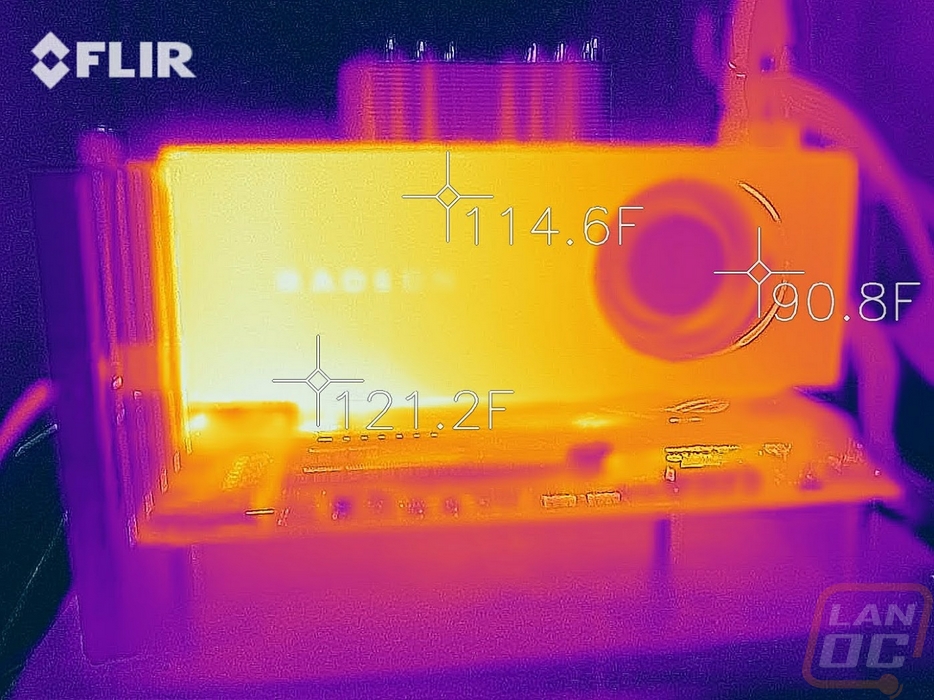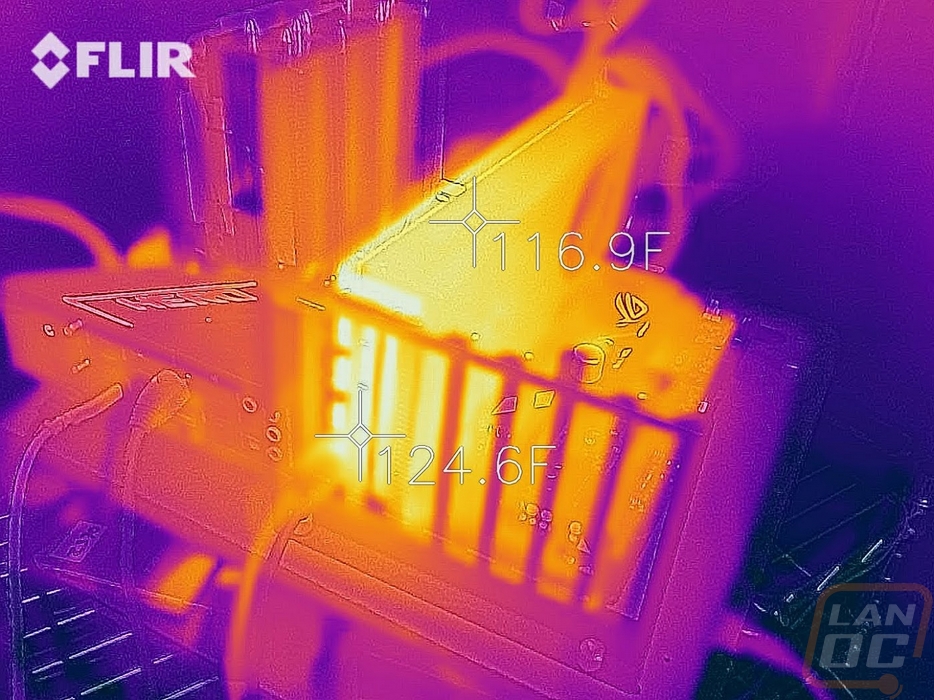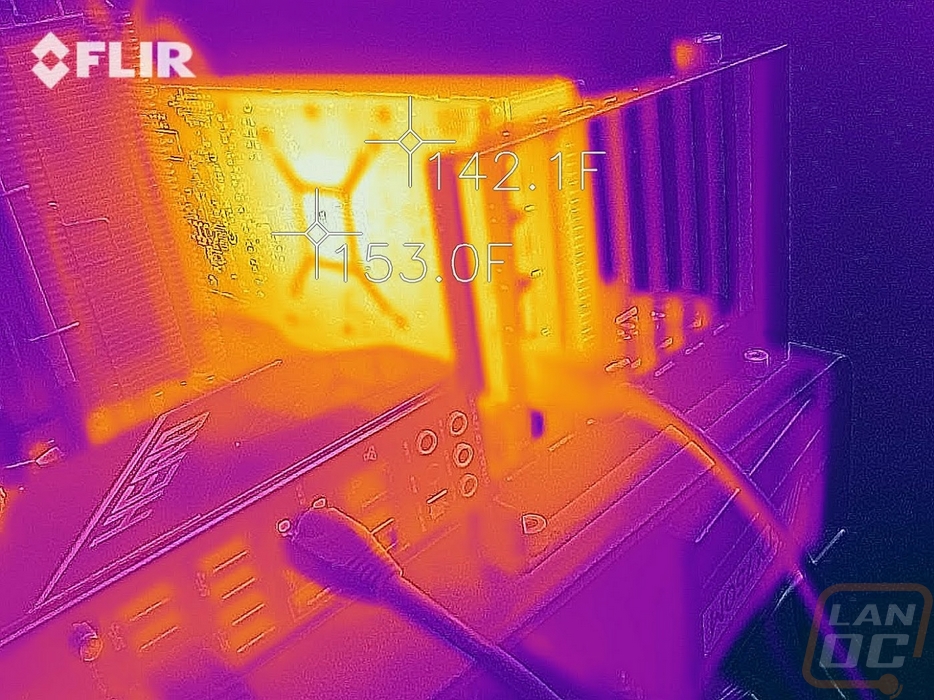Cooling, Noise, and Power
My last round of testing is also some of the most important once you have decided on which GPU model you want. That is because most cards of the same model are going to be close in performance give or take depending on the overclock, but cooling, noise, and power are all things that change from card to card and company to company. They also get even more important when you get into smaller form factor builds, huge builds heat and power isn’t a big deal.
With the RX 5700’s I was especially curious on these tests given how much power the last few AMD cards have pulled and with the decision to go with a blower design on both cards. To start things off I did my power testing. For this, I used out Kill-A-Watt and monitored the total wattage pulled from our entire test system. I ran two tests with two different load types. I used the 3DMark Fire Strike benchmark in the combined test which loads up the video card and CPU in a similar way to most games. In this test, the RX 5700 XT pulled 380 watts which was a huge improvement over the Vega 64 and the Radeon VII. It was a little higher than the RTX 2070 SUPER but behind the RTX 2080 so I wouldn’t consider that to be too bad overall. The RX 5700, on the other hand, was 50 watts less at 330 watts which was right with the RTX 2060. The second test was using AIDA64’s stress test just loading the GPU. This wattage is lower because it isn’t putting any load on the CPU or other components but it puts a more solid load on the video card itself. In this test, the RX 5700 XT pulled 308 and the RX 5700 266 watts, both noticeably higher than the Nvidia cards but not high enough to freak out about like with Vega 64.


Next noise levels are important and this isn’t specific to smaller builds. Even in a big build if the video card is loud inside you are going to notice so testing here is important. To do this I ran three tests. One at 100% fan speed, one at 50% fan speed, and a third testing the noise level when doing our thermal tests which show the loudest the fan should get in normal usage. Both of the RX 5700’s have the same fan and because it is a single fan they had to really crank the speeds up, you can see that when turned all the way up they were running at 4778 for the XT and 4681 for the normal RX 5700 which was way above all of the dual fan Nvidia cars and the triple fan Radeon VII. So when turned all the way up it wasn’t a big surprise when they were both right at the top of the chart for noise at 100% fan speed. Sadly half of that RPM is still high so at 50% they were loud as well, in fact, they were both about the same as the noise output of the water cooled Vega 64 we have. However, the last test, looking at noise levels when the card is loaded up in AIDA64 it was the Radeon VII that was the loudest with its three fans. The RX 5700 XT wasn’t far behind though at 44.3 decibels and the RX 5700 behind that at 43.5 decibels. 100% fan tests brought out an interesting issue, once you spin the fan up on either card they take AGES to come back down in speed. Normally it doesn’t take more than 30 seconds but with both RX 5700’s they took four and a half minutes and this is while they were running at idle temperatures, the fan profile is just set to have an excruciatingly slow ramp down times. Slow ramp up and ramp down times can help make fan noise less noticeable, but I think this might be a bug because I’ve never seen it happen when manually overriding the fan speed like this.



The last test is thermal testing and for this one, I run two different tests. Both use the AIDA64 stress test to load the card up and I run the test for a half hour or until the temperatures level off if it takes longer than a half hour. One test is run with the out of the box fan profile and the second I run with the fans or in this case the fan turned up to 100%. The idea is to see what you will get and what the cooler is capable of. The delta between those lets us know how much room is left for overclocking and how warm the GPU is running overall. Blower cards aren’t exactly known for running cool, but I was still surprised to see the RX 5700 XT running all the way at 88c which is nice and toasty. The RX 5700 was a little better at 78c but still not great, especially when compared with the RTX Founders Edition cars. Cranking the fan speed up helped a lot but the RX 5700 XT was still hot at 66c but the RX 5700 was down with the RTX 2060 SUPER. There was something I should point out from the 100% testing. I had no problems at all with the RX 5700 but when testing the RX 5700 XT it was riddled with driver crashes when I had the card under full load and the fan cranked up. While the RX 5700 XT was at the top of the chart at 66c, it is possible that if I didn’t have these issues with a longer test it may have gone warmer.


While doing the AIDA64 stress test with the stock fan profile I did get to check out some of the other sensor readings that AMD has on the new cards. Most video card, especially reference designs like this just have the GPU Diode and that’s about it. AMD has included a sensor on the VRM, memory, and at the GPU hotspot as well in addition to the normal location. Some aftermarket cards have been doing this and using it to know which fans to turn up or to make sure memory or VRM isn’t hot in situations where they get warmed up but the GPU isn’t getting stressed as much. The 5700 XT reached the following with the stock fan profile VRM 73c, Memory 84, Hotspot 108. The RX 5700 was the following with the stock profile VRM 61c, Memory 74c, and Hotspot at 63c. Turning the fan up to 100% on the RX 5700 it had VRM at 44c, Memory at 46c, and the hot spot was at 63c which was the same.
I also managed to get a few thermal shots of both cards as well, you can spot the 5700 XT with its grooved fan shroud and backplate and the RX 5700 without a backplate at all. Both were running hot but you can see how the blower design runs a lot warmer the farther across you get as the air gets heated up before getting to the left side of the card. Both cards also had a hotspot towards the PCI bracket up under the cards which is interesting.








